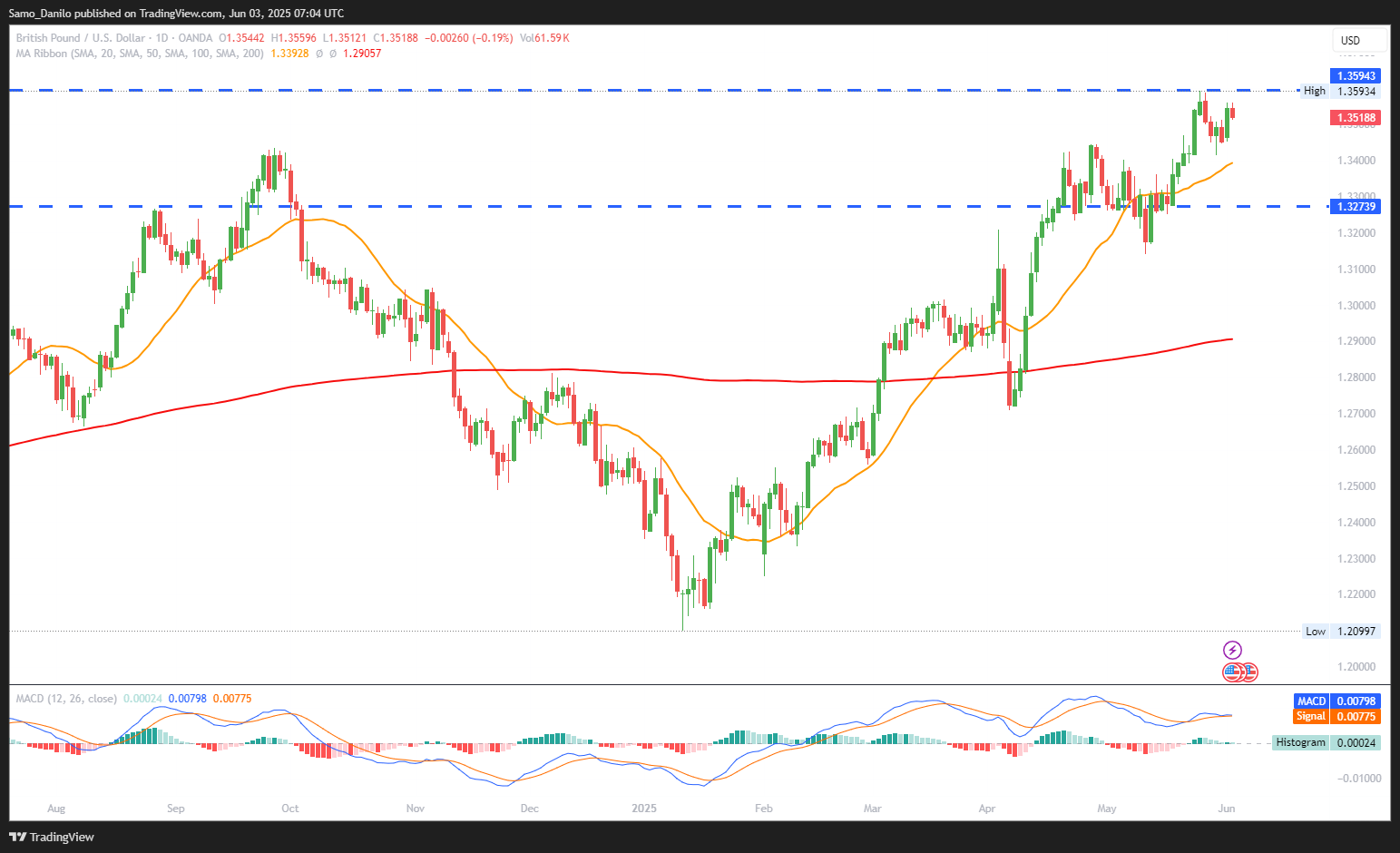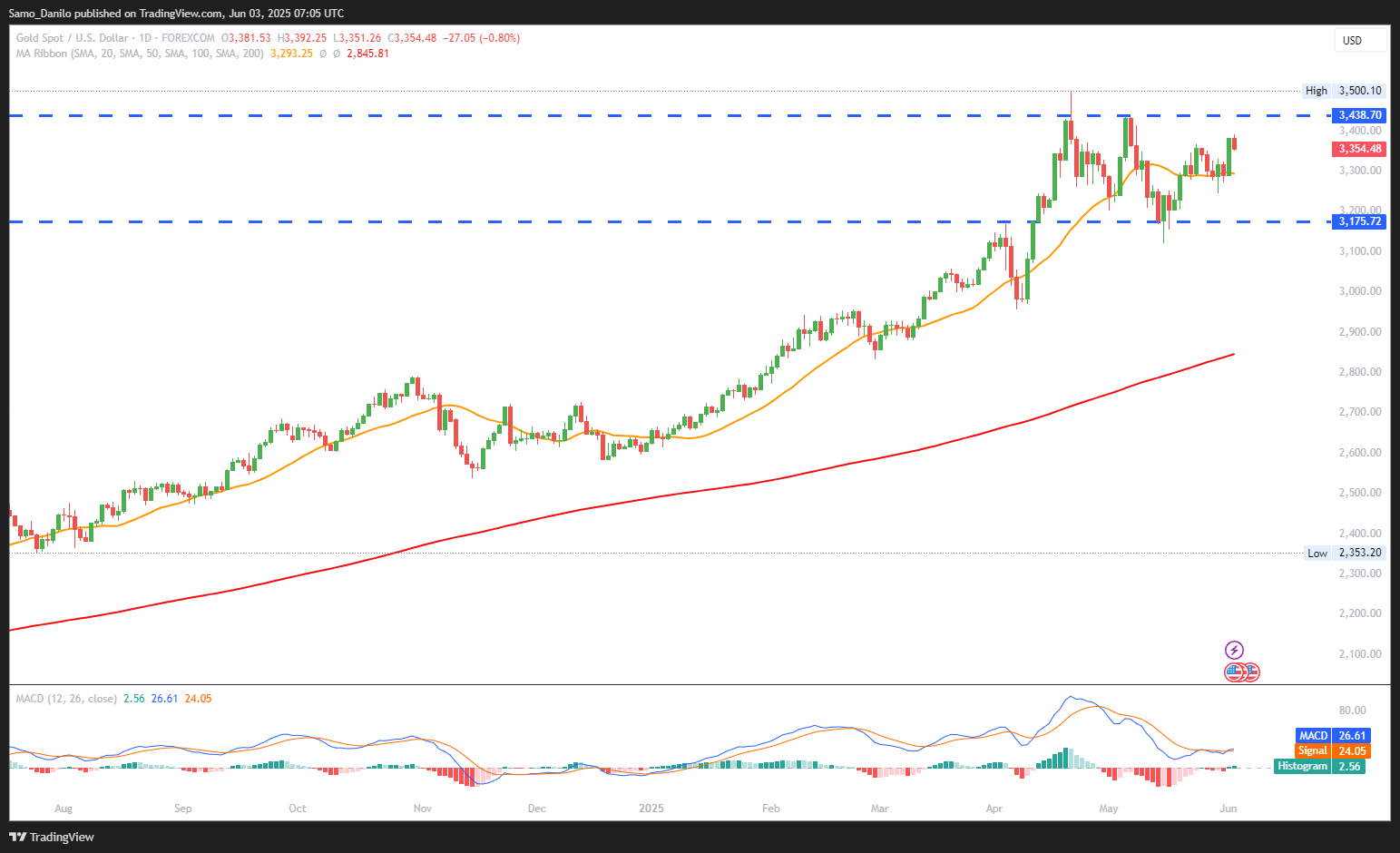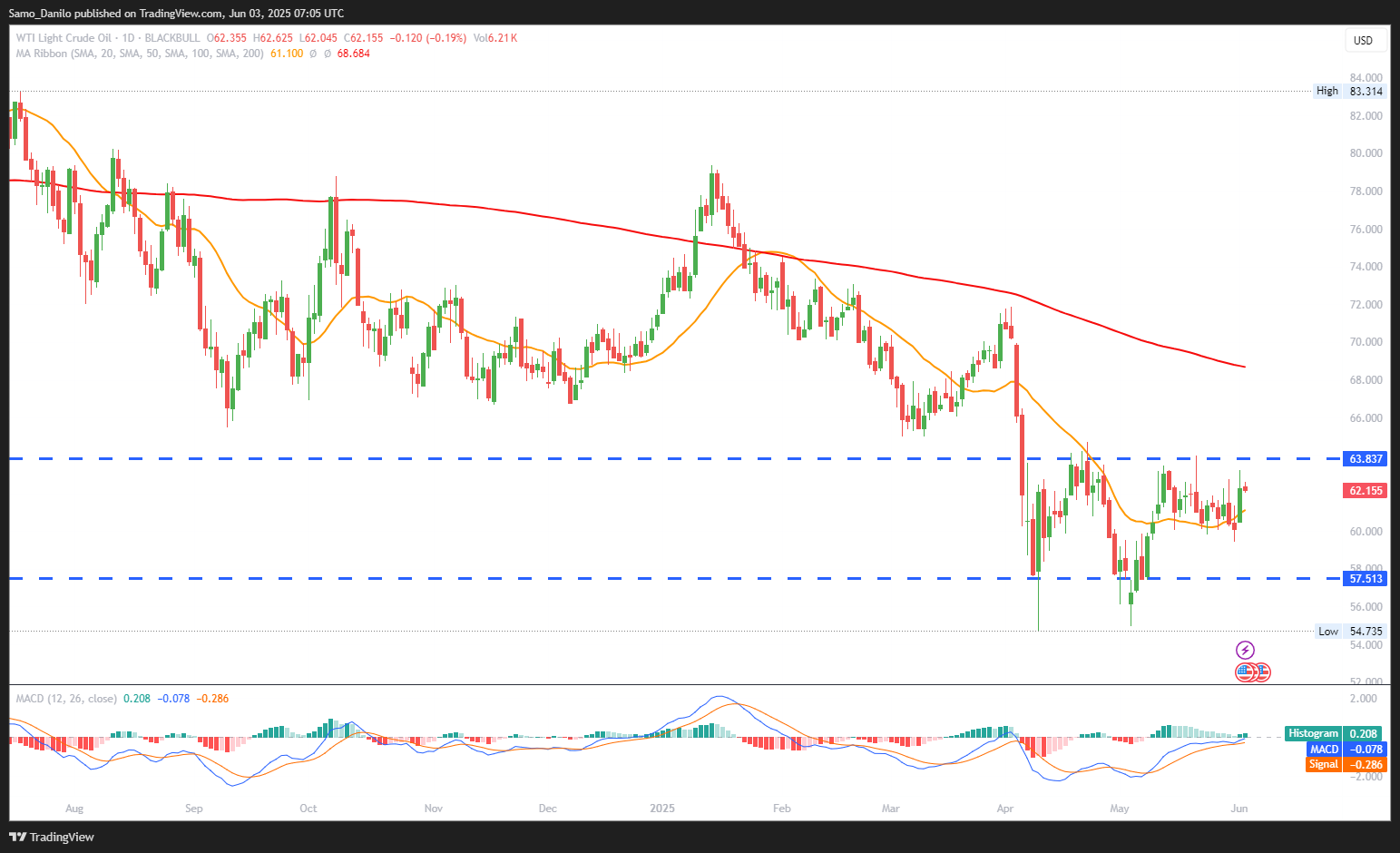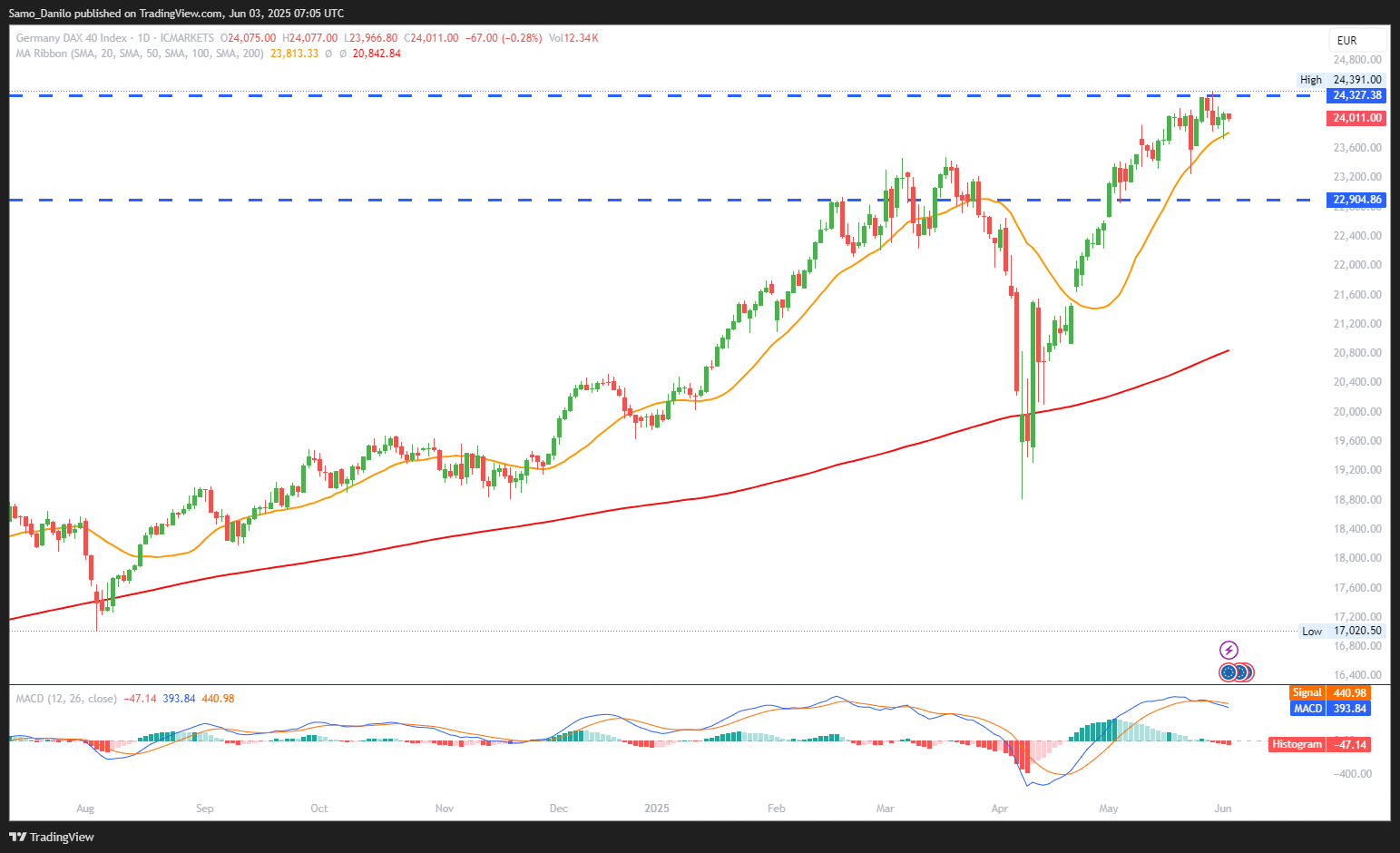EURUSD
- EUR/USD Price: The EUR/USD pair edged lower, trading around 1.1420 during Tuesday’s European session, following a gain of over 0.50% in the prior session. The pair is experiencing mild profit-taking, despite broader USD softness.
- US Steel Tariffs: President Trump announced a doubling of steel tariffs to 50%, reigniting trade tensions with the European Union.
- EU's reply: The EU responded with “strong regrets,” warning that such moves could undermine ongoing negotiations and prompt retaliatory action.
- US Manufacturing: The ISM Manufacturing PMI fell for the third consecutive month, coming in at 48.5 in May, down from 48.7 in April. The persistent contraction in US manufacturing activity reinforces concerns over slowing US growth, supporting the case for Fed policy easing.
- Eurozone Inflation: Markets now await the release of the Eurozone HICP inflation figures. Any deviation from expectations could impact ECB rate cut probabilities, especially with inflation still struggling to gain sustainable traction toward the 2% target.
Closing statement: EUR/USD remains sensitive to trade policy headlines and macro data surprises. A soft HICP print could weigh on the Euro, while persistent US growth worries may limit USD upside. Overall, the pair is in consolidation mode, with 1.1500 resistance and 1.1350 support in focus.
GBPUSD
- GBP/USD Price: The GBP/USD pair surged past 1.3550 on Monday, marking a strong start to June as the US Dollar weakened broadly. The rebound follows recent consolidations, as risk sentiment shifts in response to US-China trade friction and dovish expectations for the Federal Reserve.
- US-China Trade: President Trump criticized China’s delays in rare earths exports, prompting a strong rebuttal from Beijing, which accused the US of breaching trade terms via new tech export restrictions. The heightened rhetoric renews concerns of escalating trade hostilities, which continue to weigh on the USD.
- BoE Rate Pause: The British Pound remains buoyed by market expectations that the Bank of England (BoE) will hold rates steady at its June 18 meeting. Investors anticipate the central bank will adopt a wait-and-see approach, delaying further rate cuts in light of persistent inflation pressures.
- BoE Policy: Tuesday’s BoE Monetary Policy Report delivery to Parliament is set to reaffirm the rate-hold bias, likely strengthening the GBP if no new dovish surprises emerge. Forward guidance will be key to short-term direction for the pair.
- US Data: Markets now look to US JOLTS Job Openings and a fresh round of Fed commentary during the North American session. A weaker labor market or dovish Fed tone could reinforce downside risks for the USD, potentially extending GBP/USD’s bullish bias.
Closing statement: GBP/USD is trading with a bullish tone, underpinned by broad USD weakness, BoE rate-pause expectations, and elevated geopolitical uncertainty. Sustained momentum above 1.3550 could open the path toward 1.3600, with immediate support seen near 1.3480–1.3500.
XAUUSD
- XAU/USD Price: Gold (XAU/USD) continues to hover in negative territory during Tuesday’s Asian session, trading with a slight downside bias but lacking strong bearish conviction. Consolidation dominates price action amid mixed macro drivers and geopolitical uncertainty.
- Ukraine-Russia Talks: The second round of peace talks in Istanbul between Russia and Ukraine failed to deliver a breakthrough. Ukrainian President Zelenskyy called recent drone strikes a “success” and vowed further action unless Russia retreats. The lack of diplomatic resolution offers a mild underpinning for gold as a safe-haven hedge, though gains remain muted.
- Fed's Waller: Fed Governor Christopher Waller said on Monday that rate cuts remain possible later this year even with the Trump administration's tariffs likely to push up price pressures temporarily.
- Other Officials: Chicago Fed's Goolsbee echoed a dovish tone, pointing to a potential easing cycle over 12–18 months. However, Dallas Fed’s Logan emphasized patience, warning against premature moves if inflation expectations rise.
- Upcoming Announcements: Traders now await the US JOLTS Job Openings report and further FOMC member speeches later in the day. A weaker labor print could weaken the dollar and boost gold, while hawkish rhetoric may exert additional downside pressure on XAU/USD.
Closing statement: Gold remains under modest pressure, trading in a consolidation phase, with geopolitical tensions offering limited support. The near-term outlook hinges on incoming US labor data and Fed speak, with key support at $3,175 and resistance near $3,450.
CRUDE OIL
- Crude Oil Price: West Texas Intermediate (WTI) crude oil is trading steady around $62.00 during Monday’s European session, stabilizing as markets eye potential progress in US-China trade negotiations. The price action reflects cautious optimism despite broader supply-side complexities.
- US-China Trade: US Treasury Secretary Scott Bessent signaled over the weekend that Presidents Trump and Xi may speak soon to resolve trade tensions, including disputes over critical mineral supply chains. A breakthrough could support energy demand sentiment, especially in key manufacturing sectors.
- OPEC News: Kazakhstan’s public refusal to participate in further output cuts underscores growing internal strain within OPEC, casting doubt over the group’s cohesion. This raises risks for future production strategy alignment, potentially capping bullish momentum.
- GS Outlook: Goldman Sachs reiterated its bullish stance, citing a mix of tight spot supply, robust demand signals, and seasonal summer support. The investment bank expects OPEC+ to greenlight another 410,000 bpd hike in August, keeping fundamentals tilted toward upward pressure.
- Seasonal Trends: Persistently low US fuel inventories, coupled with the onset of the summer driving season, are helping to shore up prices. Refinery activity is expected to remain strong, adding to short-term demand for crude oil inputs.
Closing statement: WTI remains supported near $62.00 as markets weigh bullish seasonal trends and tight inventories against OPEC+ uncertainty and geopolitical noise. Short-term direction may hinge on US-China diplomacy and OPEC’s production clarity going into the August supply decision.
DAX
- DAX Price: The DAX began June slightly lower, retracing part of its strong May performance where it gained nearly 7%, extending year-to-date returns to over 20%. The modest pullback signals potential consolidation after aggressive risk-on flows in the prior month.
- Germany's Economy: Germany has overtaken Japan as the world’s largest net creditor for the first time since 1991, driven by persistent high savings and weak domestic investment. This dynamic may boost capital inflows into Europe, strengthening the euro and adding external demand to DAX-listed multinationals.
- Manufacturing Weakness: Despite gains in Eurozone and Spanish PMIs, Germany’s manufacturing sector contracted for the 35th month in a row, highlighting continued structural weaknesses. The divergence raises concerns over Germany’s industrial resilience amid global supply chain shifts.
- Job Market: German unemployment rose by 34,000 in May, triple analyst estimates, pushing the jobless count to 2.96 million, its highest level in nearly a decade outside the COVID era. This may weigh on consumer sentiment and domestic demand in the coming months.
- Business Confidence: Eurozone business confidence hit a three-year high in May, reflecting optimism around growth and rate-cut expectations. However, the potential for increased US-EU tariffs remains a material downside risk, particularly for export-heavy German industries.
Closing statement: The DAX enters June with momentum intact but faces headwinds from German labor market softness and persistent manufacturing weakness. While capital flows and investor sentiment remain supportive, geopolitical trade friction and internal economic fragilities could cap near-term upside.





